By Bus & Rail
Expo may reach La Cienega by next summer
August 4, 2010
It’s full speed ahead for the Expo Line.
A street-level, two-platform station next to Dorsey High School has been approved by the California Public Utilities Commission, setting the stage for an anticipated partial opening of the line as far as La Cienega Boulevard by next summer.
The Farmdale Avenue station to be built by Dorsey High will be an essential part of the light rail line, which will parallel the heavily-congested Santa Monica Freeway and eventually stretch from downtown to Santa Monica, attracting a projected 64,000 riders a day. The project also will include pedestrian paths and a bikeway.
Placing an Expo Line crossing at street level next to Dorsey was opposed by some in the community, who voiced concerns about the safety of students. The CPUC-approved plan to construct a street-level station at the site comes with a number of key safety enhancements, including a 15 mph speed limit for trains passing through the intersection and a requirement that trains come to a full stop to pick up and drop off passengers before proceeding into the area. Other features include gates and LED signs to signal approaching trains.
Constructing a station, rather than the crossing that originally was envisioned, will add $10 million to $15 million to the $862 million cost of the first phase of the Expo Line project. The CPUC’s decision on the matter serves as final approval for a settlement reached earlier this year among the Exposition Construction Authority, the Metropolitan Transportation Authority and the Los Angeles Unified School District.
Phase 1 will end in Culver City. That part of the project is set to be completed by the summer of 2012.
Phase 2, to extend the line to Santa Monica, is gearing up now. The final environmental impact report for the project’s $1.5 billion second phase was approved by the Exposition Metro Line Construction Authority Board in April. (Read the blog that Zev wrote before that vote here.)
Two firms—Skanska-Rados and URS-Shimmick—currently are working on preliminary engineering for Phase 2, and are competing for the design-build contract that the Expo board is expected to award in February, 2011.
LA Observed recently posted a lively YouTube video, complete with rhythmically pulsing soundtrack, of the terrain that the Expo Line eventually is expected to cover from West Los Angeles to Santa Monica. More than 23,000 viewers have already taken the virtual ride.
Posted 8/4/10
Miracle Mile subway open house
July 12, 2010
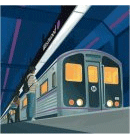 Metro has finished holding a lengthy series of community meetings on the Westside Subway extension project. But that doesn’t mean it’s too late to get an early sense of what the coming of the subway could mean to your life and commute. People who work in the Miracle Mile area are invited to an open house Wednesday, July 14, at the LACMA-Brown Auditorium, 5905 Wilshire Boulevard, to learn more about the project.
Metro has finished holding a lengthy series of community meetings on the Westside Subway extension project. But that doesn’t mean it’s too late to get an early sense of what the coming of the subway could mean to your life and commute. People who work in the Miracle Mile area are invited to an open house Wednesday, July 14, at the LACMA-Brown Auditorium, 5905 Wilshire Boulevard, to learn more about the project.
The program runs from 11 a.m. to 2 p.m. A series of presentations will be offered during the open house. Bring a brown bag lunch to supplement the light refreshments being served. More information is here.
A draft environmental impact report on the Westside subway extension—one of a dozen projects aiming for fast-track completion under the 30/10 Initiative—will be released later this summer.
Posted 7/12/10
Dial 511 to get around town
June 17, 2010
A new phone and internet service to help travelers navigate the confusing and congested maze known as Southern California made its debut this week.
Unlike sites such as Sigalert.com and Traffic.com, or good old drive time radio traffic dispatches, the new Go511.com and 511 toll-free phone service offers freeway traffic reports augmented with information about ride-sharing, carpooling, bicycling and taking the bus or train.
It’s now in beta testing mode, which means that Ken Coleman, the Metropolitan Transportation Authority’s motorist services program manager, wants to hear from you on what works—and what doesn’t—in the new service. The system offers prompts for feedback both on the phone and on the website.
Since billboards and other publicity for the service started rolling out, 511 usage is growing, topping 20,000 calls on Tuesday. Between 400 and 500 users have offered comments, two-thirds of them positive, Coleman said. Those who didn’t like it were frustrated by things like having the system’s voice recognition technology offer them travel times between two freeways rather than specifics on congestion at one point along the freeway.
The initiative is being funded for a 10-year period with $30.8 million from the Los Angeles County Service Authority for Freeway Emergencies (LA SAFE.) Most of the funds had previously been directed toward supporting a network of freeway callboxes, which are being used far less frequently these days because of the proliferation of mobile phones. (Coleman said L.A. County, which once had 4,500 callboxes, now has 1,700. In the early ‘90s, he said, 90,000 calls a month were made from the boxes. Now that number is closer to 2,500 calls a month.)
Metro’s partners in the 511 system include Caltrans, the CHP and transportation agencies in Orange and Ventura counties.
The 511 automated phone system—to be used hands-free while driving, of course—covers Los Angeles, Orange and Ventura counties, while the website offers information on San Bernardino and Riverside counties as well. Upcoming improvements include voice recognition for Spanish language prompts and smart phone applications, including a configuration of the website that works on a mobile phone.
Ultimately, Coleman envisions tapping into more sources of data to offer a comprehensive, traveler-focused service that would assist not just the region’s commuters but also tourists arriving for a visit.
Southern California, he said, “can be a very daunting place to navigate if you have no idea.” As those who live here know only too well.
Posted 6/16/10
On track for a faster train to Westwood
June 7, 2010
 It’s a frustrated motorist’s drive-time dream: ditching the westbound traffic and jumping on a subway to Westwood. That rush hour fantasy just got closer to reality with recent developments in Washington that boost the subway’s chances for federal funding while potentially making it much quicker to build.
It’s a frustrated motorist’s drive-time dream: ditching the westbound traffic and jumping on a subway to Westwood. That rush hour fantasy just got closer to reality with recent developments in Washington that boost the subway’s chances for federal funding while potentially making it much quicker to build.
How much quicker? Construction on the $4.2 billion project could start in 2013, and extend the subway all the way to Westwood by 2017. (Earlier projections had it getting as far as the Fairfax District by 2019 and not arriving in Westwood until 2036.) In other words, under the accelerated timetable, somebody who’s now in the 5th grade could be riding the subway to their freshman classes at UCLA—instead of waiting until long after they get their Ph.D.
The Westside Subway Extension is one of a dozen local transit projects that would be accelerated under the so-called 30/10 plan, which on Friday got a boost from Washington when U.S. Senator Barbara Boxer released a letter from Transportation Secretary Ray LaHood signaling administration support for the initiative. The 30/10 plan, initiated by Los Angeles Mayor Antonio Villaraigosa and unanimously supported by the Metropolitan Transportation Authority’s Board of Directors, would borrow against future Measure R funding to build in 10 years projects that ordinarily would have taken 30. (For a full list of the projects, click here.)
Boxer also announced another development with major ramifications for the Westside Subway Extension project. Instead of breaking the subway extension into three separate legs, the entire 9.3-mile stretch will now be considered as a single project by the Federal Transit Administration.
That’s important because the line’s cost-effectiveness—the number of riders and how much time they’ll save measured against the cost of the project—is more compelling with the inclusion of the Westwood station, which is projected to have between 11,000 and 14,000 boardings a day. And that could provide a competitive edge when it comes to obtaining the federal funding that will be necessary to complete the project.
“This represents the most signficant ‘good news’ for the Wilshire subway extension since the passage of Measure R in 2008,” said Supervisor Zev Yaroslavsky, a member of Metro’s Board of Directors. “Federal transit officials recognize the value of accelerating the subway extension and the other 11 Measure R transit projects so that we can realize their benefit in our lifetime.”
Aside from the federal money Metro would need to borrow as part of the 30/10 initiative, officials also are counting on the federal government to kick in about half the subway’s cost—some $2.1 billion. Since the project needs to compete with other projects around the country to secure those funds, the decision to evaluate the extension as a whole is key.
Raffi Haig Hamparian, Metro government relations manager for federal affairs, said the decision to evaluate the subway as a single project “sets the stage for a major—and some would say overdue—federal investment in Los Angeles County.” He added that the fast-tracking of the subway, along with other projects, including the Regional Connector, would move the region “one step closer to having a world class rail system in L.A. County, something voters envisioned when they overwhelmingly supported Measure R.”
Even with the latest developments in Washington, the subway project still has a long way to go before construction can start. For one thing, despite Transportation Secretary LaHood’s letter to Boxer, the 30/10 plan has yet to be formally embraced by the government. And funding for the subway under the federal “New Starts” program is not assured.
Preliminary environmental work on the project is underway now, with a series of community meetings scheduled for this summer before the planned midsummer released of a draft environmental impact report. (Here’s an informative presentation from the meetings held in April.)
Public hearings on the report will take place before it is presented to Metro’s Board of Directors In September. Once a “locally preferred alternative” route is adopted, work will begin on a final environmental impact report expected to go before the board in the fall of 2011.
Then come a number of steps—including obtaining an early commitment from the Federal Transit Administration to provide federal money for the project—before a final funding agreement could be negotiated.
Still, the latest developments from Washington mean “we’re now on a fast track,” Hamparian said. “We used to talk about the subway in the abstract—like a Picasso painting. Now people ask, ‘When is construction going to start?’ “
Posted 6/07/10
Orange Line workers take aim at toxics
May 12, 2010
Workers on the Orange Line Extension project are getting the lead out. And the asbestos, too.
Over the course of the next month or so, workers will be removing the substances from 18 buildings among the 45 to be demolished as part of the project to extend the popular rapid transit busway northward. Starting today, May 12, the work will be occurring in the busway’s right-of-way–slightly east of Canoga Avenue between Vanowen Street in Canoga Park and Lassen Street in Chatsworth—between 6 a.m. and 4 p.m. on weekdays.
“There’s no risk to the public because the contractor will have 100% containment,” says Scott McConnell, Metro senior construction manager on the project. All work will take place indoors, with continual air monitoring to make sure no toxics escape.
He says next steps include the actual demolition of the buildings, clean-up of drums of oil and paint cans left behind by several of the relocated businesses and excavating and removing contaminated soil along the one-time railroad line.
When the entire project is finished in the summer of 2012, the Orange Line Extension will extend the bus line four miles northward from Warner Center to its final destination between Devonshire and Lassen streets in Chatsworth. The line averages about 22,000 boardings each weekday now and is expected to reach 45,000 a day by 2030.
Car and foot traffic along Canoga Avenue will not be affected by the current abatement work. And there won’t be much to see.
McConnell says Metro asked the contractor: “Are there going to be guys in moon suits walking around with instruments?”
The answer was no.
Posted 5-11-10
A subway to Westwood by 2017? Maybe.
April 22, 2010
The Westside Subway Extension—along with a number of other key Southern California transit projects–could get moving a lot faster than expected under the “30/10 Initiative.” The Metropolitan Transportation Authority board today unanimously gave its backing to the initiative, which seeks to finish a dozen projects in 10 years (instead of 30) through federal loans to be repaid with Measure R funds. Now it’s up the federal government. Read more at Metro’s blog The Source.
Posted 4/22/10
Orange Line extension’s rolling forward fast
April 15, 2010
Hitesh Patel has been riding the Orange Line since Day One.
Since he lives in Yorba Linda, he hasn’t actually been a daily commuter on one of the route’s high-tech “Metro Liner” buses, which run from Warner Center to North Hollywood on compressed natural gas.
But as deputy project manager of the rapid transit busway’s original stretch, he’s been onboard throughout the planning, engineering, construction and 2005 launch of a line that wasn’t expected to attract 22,000 daily weekday riders until 2020.
It hit that ridership mark its first year out, and continues to average about that today—making it a bona fide transportation hit.
So naturally, there’s a sequel in the works. And this time, Patel is running the show.
Patel, a 13-year veteran of the Metropolitan Transportation Authority, is project manager of the Orange Line Extension, which will extend the line four miles northward from Warner Center to its final destination between Devonshire and Lassen streets in Chatsworth.
At the moment—and until the job wraps up in the summer of 2012—that makes him a very busy guy.
Ever since the contractor, Brutoco Engineering & Construction, Inc., got the go-ahead to start work in March, there’s been a flurry of activity on the project.
A new 8-foot-high “privacy fence” is going up beside a mobile home park near the Chatsworth station—of one four new stations to be built as part of the project, along with new platforms at a fifth, in Canoga Park. The fence, which shields homes from construction hassles and looky-loos, is something residents had been seeking.
“We had a big input,” says Jan McLeod, manager of the 198-home Chatsworth Mobile Home Park. “We needed the fence, so we got the fence. That was a big important thing for us. We’re not looking forward to the next couple of years, but I keep saying to the residents, ‘Remember the end goal.’ “
That end goal—greatly improving transit “connectivity” in the Valley with a line projected to carry 45,500 a day by 2030—might seem a long way off. But workers already are hustling to set the stage for construction to start in May on a 500-foot bridge over Lassen Street that is one of the project’s most ambitious elements.
To that end, workers are now preparing to relocate utility lines underground—a process that should start in May and end in the fall. That means intermittent lane closures have begun on Lassen during the day, with some night work expected as the project progresses.
In addition to navigating the host of approvals needed to start the work, Patel reports that 50 businesses leasing Metro property along the extension line already have been relocated, with two more to go by the end of the month. Three other businesses have had their leases with Metro modified, which means that their property lines are changing to allow the busway to go through. In addition, 26 billboards have been removed.
“We had a lot of challenges, but we worked through them,” Patel says.
He’s hoping that a needed agreement with Union Pacific can be obtained in coming weeks, allowing the Orange Line work to go forward across its property.
Meanwhile, Metrolink has relocated tracks and is building new rail signals to replace its current signals, which must be removed to allow for building the Lassen Street bridge.
Even before Brutoco came aboard, Metro had worked to design the parking lot north of the Chatsworth station, which is being built near the existing Metrolink parking lot. The design is intended to reflect community aesthetic preferences, including earth-tone light standards, expanded landscaping and a white split-rail fence along Devonshire.
Olga Lopez, senior community relations officer for Metro, said there’s been a fairly light volume of calls about the project so far—about 500, many of them seeking information on the extension and its route. As work accelerates, she’s expecting more. Meetings have been held with the Chatsworth and Canoga Park neighborhood councils, and more are planned.
Patel, 53—who was born in Uganda, lived in India and went to college in England—is a civil engineer by training. He worked at Caltrans before joining Metro in 1996. Given his experience on the original Orange Line, he thinks the busway’s success—with 7.46 million riders in fiscal 2008—is something to build on for the future.
“The extension will provide greater access to more of the Valley,” he says, “by improving north-south mobility and linking with the Chatsworth Metrolink station.”
And, in the words of Scott McConnell, Metro’s senior construction manager on the job, “we’re off to a good start.”
The $215.6 million extension project, which also includes a bicycle/pedestrian path, is receiving funding from Measure R, the half-cent sales tax passed by voters in 2008. Its hotline can be reached at (213) 922-3668. The email address is [email protected].
Posted 4-21-10
How to go blue and green at the same time
April 15, 2010
The Dodgers’ home stand is continuing through the weekend and fans who want to leave the driving—and parking–to someone else can travel via Dodger Stadium Express bus service from Union Station. Opening Day boasted about 2,900 boardings on the clean energy buses. And yes, you can leave at the 7th inning stretch if you must. Here’s how it all works.
Meet up to plan the subway
March 31, 2010
Want to have a say in what your subway will look like and where it will go?
As planners prepare to extend the subway westward, Metro is headed back to the Westside for a new series of community meetings this spring.
The meetings, which begin April 12, will feature updates on station planning, locations and design. Metro’s last round of community meetings in the fall of 2009 regularly attracted hundreds of people.
This time around, Metro officials will provide preliminary information on the five alternative routes for the extension currently under review. These proposed routes would add branches and stations at varying points throughout the Westside, including stations at Wilshire/Crenshaw and in the Westwood/UCLA area.
Information and community input from the meetings will be considered before Metro releases a Draft Environmental Impact Statement/Environmental Impact Report (Draft EIS/EIR) this coming summer. Technical analysis and development plans in the Draft EIS/EIR will be made available for public review before construction begins on the project.
Meeting schedules and summaries of past meetings are available here.
Posted 3/31/10




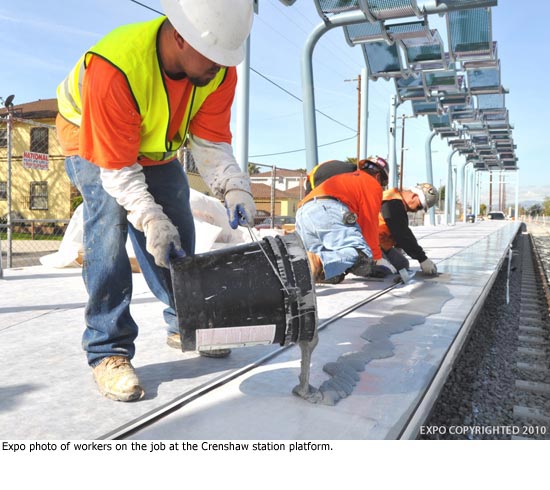
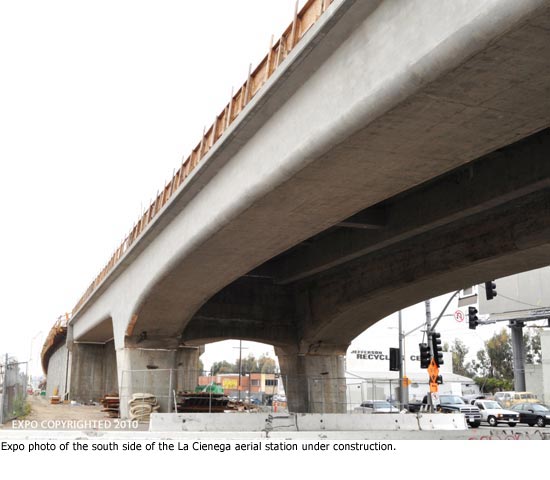
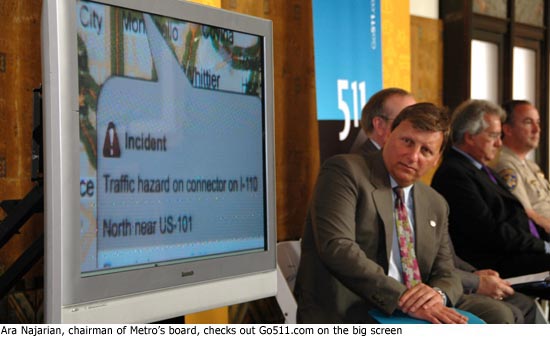

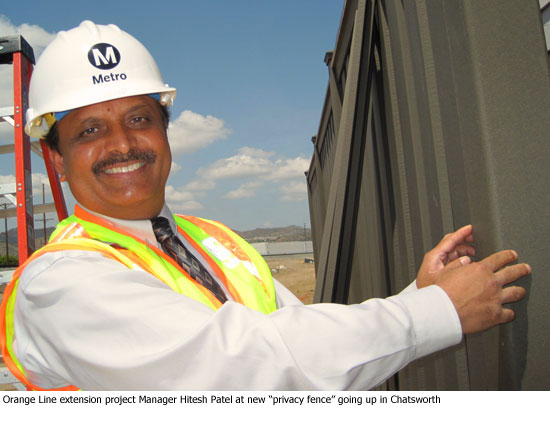

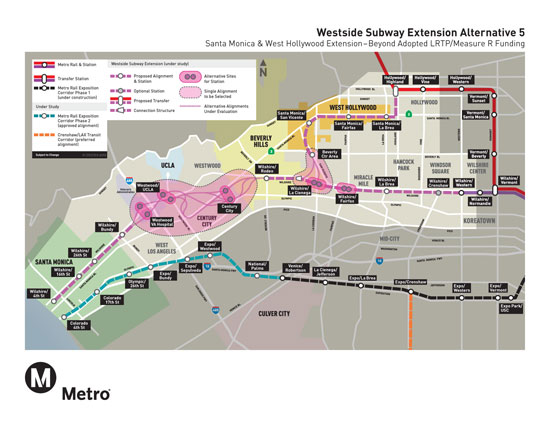







 405 bridge work causes a stink
405 bridge work causes a stink

